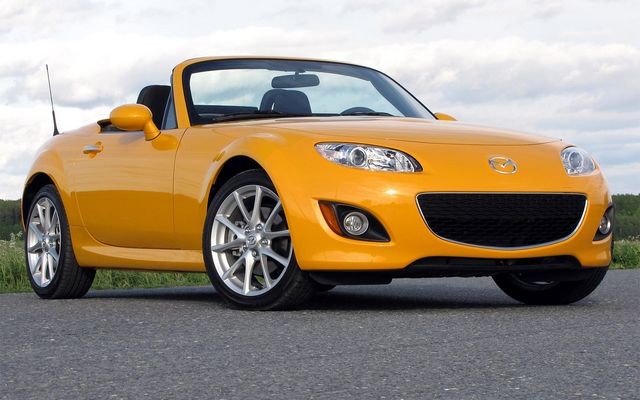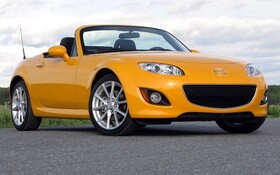2009 Mazda MX-5 Miata: Twenty years young and still looking good
February 1989: It cruises in to the Chicago Auto Show like some kind of UFO. No one was expecting it. No rumours about it had been leaked, and no auto paparazzi had released photos of it. It was a small, simple roadster, vaguely reminiscent of the first Lotus Elan from the 60s. Both its architecture and list of technical specs seemed inspired by the kind of British sports car that fell off the map in North America during the mid-70s. And yet the execution was typically Japanese, with special attention to detail and excellent construction.
Although officially named the MX-5, it quickly became known as the Miata, which means “gift” in old German. Legend has it that the idea for a small, classic sports car was pitched to Kenichi Yamamoto in 1976 by Bob Hall, an American auto journalist who was fluent in Japanese. At the time, this brilliant engineer, nicknamed “the father of the rotary engine,” was leading Mazda’s research and development department. And it seems that Hall’s idea did not fall on deaf ears.
- Also: Inner Child or Mid-Life Crisis? The New 2009 Mazda MX-5
- Also: 2009 Mazda MX-5, always the fun-to-drive roadster
Green light from the boss
Five years later, in 1981, Hall was working for Mazda’s American division and Yamamoto was head of Mazda’s Hiroshima office. Having an appreciation for bold, new ideas, Yamamoto gave Hall the green light to oversee the creation of a petite sports car. The vehicle was developed behind closed doors over several years. International Automotive Design (IAD) of England built the first prototypes, but the design and development of the base model were done in Japan.
After the surprise unveiling in Chicago, the Miata was officially launched on the island of Oahu in Hawaii. Equipped with a 116-horsepower 1.6-litre 4-cylinder engine, this sports car was no hot rod. But it was magic nonetheless. People walking by in the streets of Waikiki stopped us to ask how much it cost, and some even offered to buy it on the spot.
The Miata’s soft top could fold down in five seconds, its manual transmission was precise and crisp enough for a Formula 1600 car, and the sound of its exhaust, which was carefully studied, was like sweet music to the ear. Weighing in at 950 kg or 2,100 pounds (just barely a tonne), the Miata was delightfully agile, wonderfully balanced and featured lively and precise steering (power-assistance was optional). I was dazzled by the intelligence behind every detail, such as covering the rather modest engine (borrowed from the 323) with a metal cylinder head cover, which was like those classic English twin cams.
Working its magic
Of course, the Miata had a few faults, objectively speaking, but it still seemed about as perfect as a car could be in those days. The title of the first article I wrote after testing it had the word “miracle” in it, and the vehicle certainly didn’t let me down from there. This fresh, new thing oozed charm and was an instant hit – which naturally got the creative juices flowing at other manufacturers.
Were it not for the Miata, we would never have had the BMW Z3, the Mercedes-Benz SLK, or the Porsche Boxster. In fact, we can credit this vehicle with a veritable rebirth of the classic sports car and roadster category: a front engine under a long hood, and power flowing to the rear wheels positioned just behind the two seats.
By 2000, 500,000 Miatas had been sold, making it the most popular sports car in history. Today, with some 900,000 sold, Mazda is looking forward to breaking the 1 million mark.
Changes through the generations
The first generation of the Miata includes the model years of 1990 to 1998, during which time the only major change was the long-awaited switch to a 128-horsepower 1.8-litre engine in 1994. Two years later, the engine could pump out 133 horsepower. That was enough to propel the Miata from 0-100 in 8.34 seconds (in contrast with the first Miata, which took 9.32 seconds to reach that speed, due to its 1.6-litre engine).
Launching in 1999, the second generation of this highly popular car involved no major metamorphosis. The basic body dimensions remained practically the same. The only changes were a slight increase to the front and back track width, a more rigid structure, and improved calibration of the suspension. They also moved the battery and spare tire as a means of maximizing cargo space. The engine power was upped to 140 horses and additional modifications resulted in added torque as well.
The most obvious change in the second generation was that the flip lights were replaced by static ones, helping reduce the slightly redesigned body’s drag coefficient from 0.39 to 0.37. This second-gen Miata, however, came out a little heavier due to the addition of certain accessories that by then were considered must-haves, such as front airbags and ABS brakes (which brought down the emergency braking distance to an impressive 6 m at 100 km/h). More changes came in 2001: reinforced body, bigger brakes, two more horses for the engine and extra torque with the variable-valve timing. The most impressive second generation model was released in 2004: the Miata Mazdaspeed. Its turbocharged 1.8-litre engine churned out 178 horsepower at 6,000 rpm and delivered 166 lb.-ft. of torque at 4,500 rpm, which was distinctly more than the 125 lb.-ft. at 5,000 rpm from the naturally aspirated engine. With stats like 0-100 km/hr in 6.88 seconds and a quarter mile in 15.2 seconds, the 2004 model still holds the record among base-model Miatas.
DESPITE THIS LEVEL OF PERFORMANCE, MIATA SALES CONTINUED ON A SLOW BUT STEADY DECLINE. IT WAS OBVIOUS THAT THE VEHICLE NEEDED TO BE REVAMPED, AND QUICKLY. THIS PROMPTED MAZDA TO LAUNCH A THIRD GENERATION OF ITS ROADSTER IN 2006. ALTHOUGH MODEST, IT TURNED OUT TO BE A MAJOR SUCCESS.
FROM SECOND GENERATION TO THIRD
THE 2006 VERSION OF THE MIATA WAS ALL-NEW YET PERFECTLY RECOGNIZABLE. KUDOS TO THE MAZDA TEAM FOR RESISTING THE TEMPTATION TO PUMP THEIR BEAUTY QUEEN FULL OF STEROIDS AS A MEANS OF CHALLENGING THEIR COMPETITORS (WHICH HAD BECOME NUMEROUS OVER THE YEARS). OFFICIALLY, THIS NEW MX-5 NO LONGER BORE THE MIATA NAME, BUT WE DIDN’T CARE, IT WAS STILL A MIATA TO US.
DESPITE THE FACT THAT THE BODY WAS ALL-NEW, THE 2006 MIATA BORE A STRIKING RESEMBLANCE TO ITS PREDECESSORS. WITH MORE PRONOUNCED ARCHED WINGS, IT HAD A STOCKIER, MORE MODERN LOOK, WHICH WAS APPROPRIATE GIVEN THAT THE BODY WAS STRETCHED ANOTHER 6.4 CM LONG AND 4.4 CM WIDE, AND THE WHEELBASE ALSO GOT ANOTHER 6.4 CM IN LENGTH. THE RESULT WAS A MORE SPACIOUS INTERIOR, THOUGH IT STILL WASN’T ROOMY ENOUGH FOR LONG-LEGGED FOLKS.
THE 2006 MIATA WAS ABLE TO BETTER LEVERAGE ITS LARGER SIZE THANKS TO A MULTI-LINK REAR SUSPENSION, WHICH VIRTUALLY ELIMINATED THE REAR SWAY THAT MIATA DRIVERS HAD BEEN PUTTING UP WITH (IN VARYING DEGREES) FOR YEARS. THIS ALSO ALLOWED THE MIATA TO MAKE THE MOST OF ITS 2.0-LITRE ENGINE, WHICH PUMPED OUT 167 HORSEPOWER AT 7,000 RPM AND 140 LB.-FT. OF TORQUE AT 5,000 RPM. AND DESPITE THE ADDED SIZE AND POWER, THIS MIATA HAD ONLY TAKEN ON ANOTHER 20 KG.
THE FOLLOWING YEAR, MAZDA CAME OUT WITH ANOTHER SMOKING-HOT OPTIONAL FEATURE: A RETRACTABLE HARD TOP THAT COULD SLIDE OUT OF SIGHT IN JUST 15 SECONDS AND INFRINGED ONLY SLIGHTLY ON TRUNK SPACE. THIS AT A TIME WHEN THE MIATA’S NEW AMERICAN RIVALS, THE SOLSTICE AND THE SKY, WERE ONLY AVAILABLE WITH UNAPPEALING SOFT TOPS. WHAT’S MORE, THE MIATA’S NEW RETRACTABLE ROOF WAS EVEN CHEAPER THAN THE FIXED HARD TOP THAT HAD BEEN AVAILABLE AS AN OPTION UNTIL THEN. EVEN CARRYING THE HARD TOP’S EXTRA 35 KG, THE MIATA AND ITS SIX-SPEED MANUAL GEARBOX COULD SPRINT FROM 0-100 KM/HR IN 7.03 SECONDS AND CHEW THROUGH A QUARTER MILE IN 15.31 SECONDS – NEARLY AS FAST AS THE MAZDASPEED.
Still a pleasure
With all this progress, you might think that the team in Hiroshima would sit back on their laurels – but that’s not what happened. The decided to give the 2009 Miata a large front grille, like the one on the Mazda3, and they improved the suspension and engine settings. The engineers also shortened the last gear a little to allow faster accelerations and reduce fuel consumption.
The GX version is less expensive than the more luxurious GT, but I opted to take out the GS for this anniversary test drive. The GS is the sportiest of them all, with a six-speed manual transmission, Torsen limited-slip differential and fabric-covered seats – just like the first-generation Miata. When I took it out on the Sanair circuit, the GS hugged the slow curves beautifully and offered some great drift from all four tires on the fastest curve.
Once on the highway, the Miata handles as precisely as ever, while its leather-covered steering wheel lets you know just what the road beneath you is like. As I finished my test drive, the nearly-new engine was purring more freely and demonstrated even better flexibility. There was just barely enough room for my shoe on the footrest, and I found there was quite a lot of cabin noise with the hard top up. Luckily, the solution was at my fingertips. I stopped, pulled a latch and pressed a button. Fifteen seconds later, full sky overhead. I engaged the clutch, made my way up through the gears, and found myself wearing a grin as big as the front grille. Magic, I tell you.












